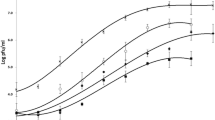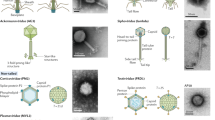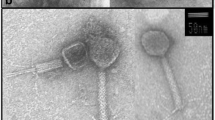Abstract
Tailed bacteriophages are the most abundant viruses in the biosphere. Here we examined the T4-type bacteriophage community inhabiting the surface of two glaciers in Svalbard. We used a molecular approach to target g23, the major capsid protein gene, to demonstrate that in the extreme cryoconite hole habitats the T4-type phages are surprisingly diverse. Phylogenetic analysis revealed that cryoconite hole sediments harbour a mixed phage community spanning multiple T4-type phage subgroups. The majority (71 %) of phage sequences clustered into three novel phylogenetically distinct groups, whilst the remainder clustered with known marine and soil derived phage sequences. The meltwater in cryoconite holes also contained a further distinct phage community which was related to previously detected marine phage variants. The ability of phages to move between marine and glacial habitats was tested in a transplantation experiment. Phages from the nearby marine fjord were found to be capable of initiating infection of supraglacial bacteria, suggesting suitable hosts could be found by non-native phages. Together this evidence suggests that the surface of glaciers contain both novel and cosmopolitan phages, some of which may have arrived in the cryosphere from other biomes.



Similar content being viewed by others
References
Anesio AM, Mindl B, Laybourn-Parry J, Hodson AJ, Sattler B (2007) Viral dynamics in cryoconite holes on a high Arctic glacier (Svalbard). J Geophys Res Biogeosci 112
Baas-Becking (1934) Geobiologie of inleiding tot de milieukunde. In: van Stockum WP, Zoon NV (eds). The Hague, Netherlands
Baker AC, Goddard VJ, Davy J, Schroeder D, Adams G, Wilson WH (2006) Identification of a diagnostic marker to detect freshwater cyanophages of filamentous cyanobacteria. Appl Environ Microbiol 72:5713–5719
Benn D, Evans D (1997) Glaciers and glaciation. John Wiley & sons, New York
Bonilla-Findji O, Rochelle-Newall E, Weinbauer MG, Pizay MD, Kerros ME, Gattuso JP (2009) Effect of seawater–freshwater cross-transplantations on viral dynamics and bacterial diversity and production. Aquat Microb Ecol 54:1–11
Breitbart M, Rohwer F (2005) Here a virus, there a virus, everywhere the same virus? Trends Microbiol 13:278–284
Breitbart M, Salamon P, Andresen B, Mahaffy JM, Segall AM, Mead D, Azam F, Rohwer F (2002) Genomic analysis of uncultured marine viral communities. Proc Natl Acad Sci USA 99:14250–14255
Breitbart M, Felts B, Kelley S, Mahaffy JM, Nulton J, Salamon P, Rohwer F (2004a) Diversity and population structure of a near-shore marine-sediment viral community. Proc R Soc Lond B Biol Sci 271:565–574
Breitbart M, Miyake JH, Rohwer F (2004b) Global distribution of nearly identical phage-encoded DNA sequences. FEMS Microbiol Lett 236:249–256
Butina TV, Belykh OI, Maksimenko SY, Belikov SI (2010) Phylogenetic diversity of T4-like bacteriophages in Lake Baikal, East Siberia. FEMS Microbiol Lett 309:122–129
Chen F, Suttle CA, Short SM (1996) Genetic diversity in marine algal virus communities as revealed by sequence analysis of DNA polymerase genes. Appl Environ Microbiol 62:2869–2874
Deng L, Hayes PK (2008) Evidence for cyanophages active against bloom-forming freshwater cyanobacteria. Freshw Biol 53:1240–1252
Edwards A, Anesio AM, Rassner SM, Sattler B, Hubbard B, Perkins WT, Young M, Griffith GW (2011) Possible interactions between bacterial diversity, microbial activity and supraglacial hydrology of cryoconite holes in Svalbard. ISME J 5:150–160
Filée J, Tétart F, Suttle CA, Krisch HM (2005) Marine T4-type bacteriophages, a ubiquitous component of the dark matter of the biosphere. Proc Natl Acad Sci USA 102:12471–12476
Hagen JO, Kohler J, Melvold K, Winther JG (2003) Glaciers in Svalbard: mass balance, runoff and freshwater flux. Polar Res 22:145–159
Hodson A, Anesio AM, Ng F, Watson R, Quirk J, Irvine-Fynn T, Dye A, Clark C, McCloy P, Kohler J, Sattler B (2007) A glacier respires: quantifying the distribution and respiration CO2 flux of cryoconite across an entire Arctic supraglacial ecosystem. J Geophys Res Biogeosci 112
Hodson A, Anesio AM, Tranter M, Fountain A, Osborn M, Priscu J, Laybourn-Parry J, Sattler B (2008) Glacial ecosystems. Ecol Monogr 78:41–67
Hood E, Fellman J, Spencer RGM, Hernes PJ, Edwards R, D’Amore D, Scott D (2009) Glaciers as a source of ancient and labile organic matter to the marine environment. Nature 462:1044–1047
Jia ZJ, Ishihara R, Nakajima Y, Asakawa S, Kimura M (2007) Molecular characterization of T4-type bacteriophages in a rice field. Environ Microbiol 9:1091–1096
Judd KE, Crump BC, Kling GW (2006) Variation in dissolved organic matter controls bacterial production and community composition. Ecology 87:2068–2079
Jungblut AD, Lovejoy C, Vincent WF (2010) Global distribution of cyanobacterial ecotypes in the cold biosphere. ISME J 4:191–202
Kastovská K, Elster J, Stibal M, Santrůcková H (2005) Microbial assemblages in soil microbial succession after glacial retreat in Svalbard (high Arctic). Microb Ecol 50:396–407
King AMQ, Adams MJ, Carstens EB, Lefkowitz EJ (2011) Virus taxonomy: classification and nomenclature of viruses: Ninth Report of the International Committee on Taxonomy of Viruses. Elsevier Academic Press, San Diego
Liu J, Wang G, Zheng C, Yuan X, Jin J, Liu X (2011) Specific assemblages of major capsid genes (g23) of T4-type bacteriophages isolated from upland black soils in Northeast China. Soil Biol Biochem 43:1980–1984
López-Bueno A, Tamames J, Velazquez D, Moya A, Quesada A, Alcami A (2009) High diversity of the viral community from an Antarctic Lake. Science 326:858–861
Paterson WSB (1994) The physics of glaciers, 3rd edn. Butterworth-Heinermann, Oxford
Pearce DA, Cockell CS, Lindstrom ES, Tranvik LJ (2007) First evidence for a bipolar distribution of dominant freshwater lake Bacterioplankton. Antarct Sci 19:245–252
Sano E, Carlson S, Wegley L, Rohwer F (2004) Movement of viruses between biomes. Appl Environ Microbiol 70:5842–5846
Säwström C, Laybourn-Parry J, Graneli W, Anesio AM (2007a) Heterotrophic bacterial and viral dynamics in Arctic freshwaters: results from a field study and nutrient-temperature manipulation experiments. Polar Biol 30:1407–1415
Säwström C, Graneli W, Laybourn-Parry J, Anesio AM (2007b) High viral infection rates in Antarctic and Arctic Bacterioplankton. Environ Microbiol 9:250–255
Short CM, Suttle CA (2005) Nearly identical bacteriophage structural gene sequences are widely distributed in both marine and freshwater environments. Appl Environ Microbiol 71:480–486
Smith DC, Azam F (1992) A simple, economical method for measuring bacterial protein synthesis rates in seawater using tritiated-leucine. Marine Microbial Food Webs 6:107–114
Staley JT, Gosink JJ (1999) Poles apart: biodiversity and biogeography of sea ice bacteria. Annu Rev Microbiol 53:189–215
Stibal M, Sabacká M, Kastovská K (2006) Microbial communities on glacier surfaces in Svalbard: impact of physical and chemical properties on abundance and structure of cyanobacteria and algae. Microb Ecol 52:644–654
Stibal M, Tranter M, Benning LG, Řehák J (2008) Microbial primary production on an Arctic glacier is insignificant in comparison with allochthonous organic carbon input. Environ Microbiol 10:2172–2178
Stres B, Philippot L, Faganeli J, Tiedje JM (2010) Frequent freeze-thaw cycles yield diminished yet resistant and responsive microbial communities in two temperate soils: a laboratory experiment. FEMS Microbiol Ecol 74:323–335
Tamura K, Dudley J, Nei M, Kumar S (2007) MEGA4: molecular evolutionary genetics analysis (MEGA) software version 4.0. Mol Biol Evol 24:1596–1599
Telling J, Anesio AM, Tranter M, Irvine-Fynn T, Hodson A, Butler C, Wadham J (2011) Nitrogen fixation on Arctic glaciers, Svalbard. J Geophys Res Biogeosci 116
Wang G, Hayashi M, Saito M, Tsuchiya K, Asakawa S, Kimura M (2009a) Survey of major capsid genes (g23) of T4-type bacteriophages in Japanese paddy field soils. Soil Biol Biochem 41:13–20
Wang G, Jin J, Asakawa S, Kimura M (2009b) Survey of major capsid genes (g23) of T4-type bacteriophages in rice fields in Northeast China. Soil Biol Biochem 41:423–427
Wang G, Yu Z, Liu J, Jin J, Liu X, Kimura M (2011) Molecular analysis of the major capsid genes (g23) of T4-type bacteriophages in an upland black soil in Northeast China. Biol Fertil Soils 47:273–282
Waterhouse AM, Procter JB, Martin DMA, Clamp M, Barton GJ (2009) Jalview Version 2 - a multiple sequence alignment editor and analysis workbench. Bioinformatics 25:1189–1191
Wommack KE, Colwell RR (2000) Virioplankton: viruses in aquatic ecosystems. Microbiol Mol Biol Rev 64:69–114
Yooseph S, Sutton G, Rusch DB, Halpern AL, Williamson SJ, Remington K, Eisen JA, Heidelberg KB, Manning G, Li W, Jaroszewski L, Cieplak P, Miller CS, Li H, Mashiyama ST, Joachimiak MP, van Belle C, Chandonia JM, Soergel DA, Zhai Y, Natarajan K, Lee S, Raphael BJ, Bafna V, Friedman R, Brenner SE, Godzik A, Eisenberg D, Dixon JE, Taylor SS, Strausberg RL, Frazier M, Venter JC (2007) The Sorcerer II global ocean sampling expedition: expanding the universe of protein families. PLoS Biol 5:432–466
Acknowledgments
This research was funded by the UK Natural Environmental Research Council (NERC—NE/G00496X/1 and NE/J013854/1) to AMA. CMB was funded by a NERC Doctoral Training Programme grant. We would like to thank three anonymous reviewers for valuable comments to an earlier draft of this manuscript. We would also like to thank staff at the NERC Arctic Research Station for logistical support and field assistance.
Author information
Authors and Affiliations
Corresponding author
Additional information
Communicated by S. Albers.
Electronic supplementary material
Below is the link to the electronic supplementary material.
792_2013_569_MOESM1_ESM.pdf
Online resource 1 Amino acid alignments of representative g23 fragments from cryoconite holes (AB, VB and CRY prefix) and a proglacial lake (PRO prefix) alongside similar representatives from GenBank. A blue background indicates that amino acid motifs were conserved for >90 % of the sequences. A dash indicates a space was inserted to preserve the alignment. The two regions excluded from the phylogenetic analysis are encompassed by the grey boxes. (PDF 1215 kb)
792_2013_569_MOESM2_ESM.pdf
Online resource 2 g23 sequence fragment matches to GenBank. For each cryoconite clone the closest match to GenBank is listed as a GenBank ID number and also clone number to aid in clone identification in the phylogenetic tree. Sequence length refers to amino acid length. Location and environment refer to the nearest matching GenBank clone. (PDF 313 kb)
Rights and permissions
About this article
Cite this article
Bellas, C.M., Anesio, A.M. High diversity and potential origins of T4-type bacteriophages on the surface of Arctic glaciers. Extremophiles 17, 861–870 (2013). https://doi.org/10.1007/s00792-013-0569-x
Received:
Accepted:
Published:
Issue Date:
DOI: https://doi.org/10.1007/s00792-013-0569-x




